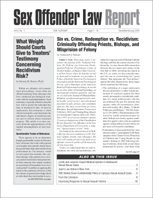HIV Status and Related Legislation, Part I
Author: Roslyn Myers, J.D..; Jorge Jacobo, J.D..
Source: Volume 06, Number 05, August/September 2005 , pp.67-69(3)

< previous article |next article > |return to table of contents
Abstract:
Editor’s Note: The AIDS epidemic, which was originally viewed as a “gay” disease and therefore treated as a distant threat to the general population, became a part of the mainstream when heterosexuals began testing positive for the virus. Since then, legislation has been enacted in fits and spurts to contain the spread of the disease, especially by knowing transmission. Many states have partner notification statutes that require doctors to notify any known partners of a patient who tests positive for HIV, but patients must volunteer the information about whom to contact. (See, e.g., N.Y. Comp. Codes R. & Regs. tit. 10, § 63.4(b) (West 2001), available at www.health.state.ny.us/nysdoh/rfa/hiv/full63. htm (requiring physicians to notify known contacts, including spouses, of patients diagnosed with HIV and to report to health commissioner the identity of known contacts for partner notification purposes). See sidebar, Appendix of State Laws on HIV Partner Notification.) Under victims’ rights laws, all states notify victims of sex crimes if their offender tests positive for the virus. Some states inform victims of the offender’s HIV status even if the crime did not involve transmission. (See, e.g., Fl. Stats. Ann. § 960.003.) And many states have made it a crime to knowingly transmit the HIV virus. (See, e.g., Ind. Code §§ 16- 41-7-1, 35-42-1-9 (Failure of Carriers of Dangerous Communicable Diseases to Warn Persons at Risk).) But the threat of HIV infection has not yet intersected with sex offender registration requirements.Keywords:
Affiliations:
.